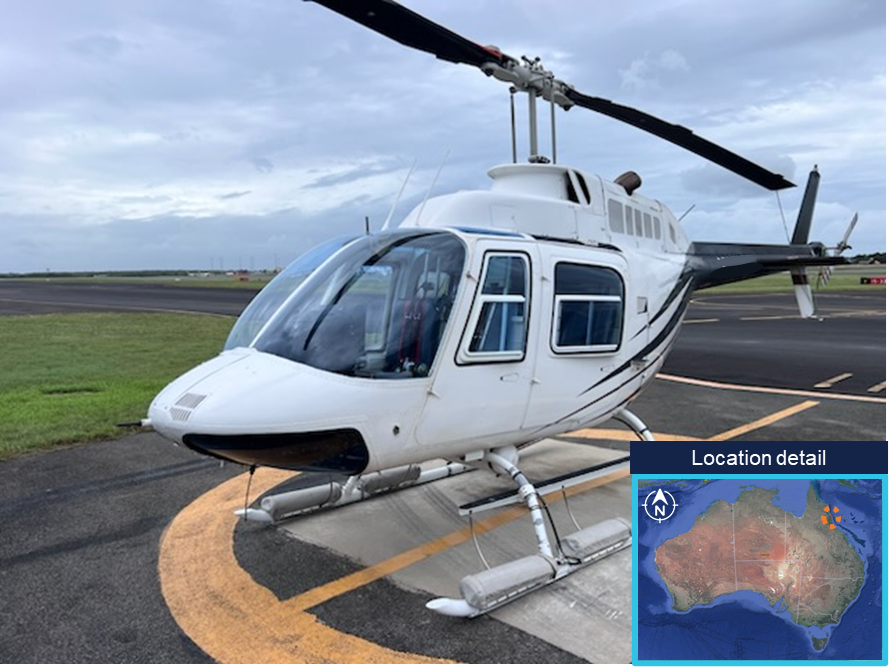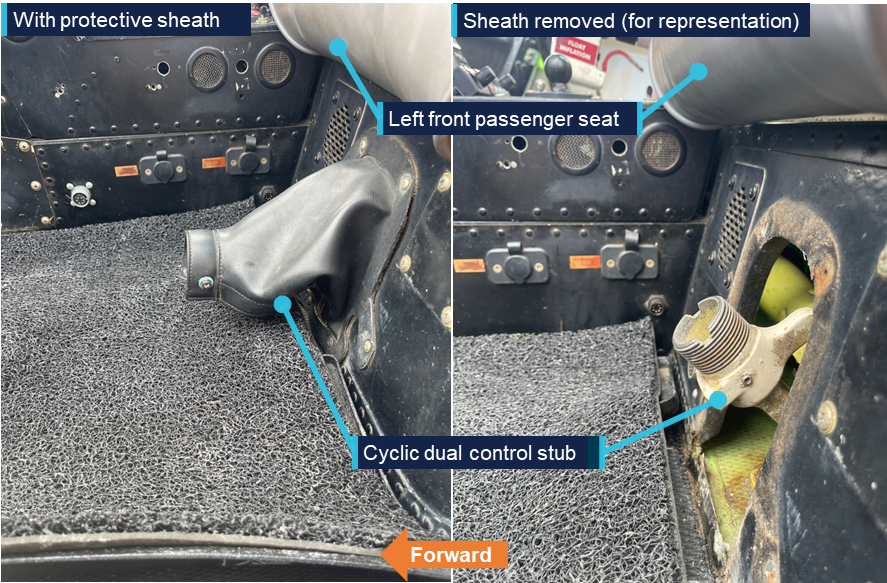What happened
On 8 February 2025, the pilot of a Bell Helicopter 206B was conducting a scenic flight from Cairns Airport, Queensland (Figure 1). The passengers comprised 2 adults and 2 children, with 1 child placed in the front left seat and the remaining passengers in the rear of the helicopter.
Figure 1: Bell Helicopter 206B with incident location (inset)

Source: Operator and Google Earth, annotated by the ATSB
Approximately 12 minutes into the flight, the pilot contacted the operator over the company radio and expressed concern about the operation of the flight controls. The control issues were similar to a previously reported occurrence from approximately a month earlier, where the pilot had experienced an aft ‘kick’ in the flight controls, followed by stiffening of both the cyclic and the collective controls. On this occasion, the pilot also experienced the cyclic control moving to the right.
Following the previous occurrence, the operator conducted a technical assessment of the aircraft’s hydraulic system, but no abnormalities were detected, and the precise cause of the issue was not identified.
On this occasion, on being notified of the issue by the pilot during flight, the operator immediately advised the pilot to check the front seat passenger’s feet position. The pilot observed that the passenger’s feet were interfering with the copilot cyclic[1] control stub. The stub was a small moveable part that remained on the floor of the helicopter under the seat, after the copilot cyclic control stick had been removed (Figure 2).
Figure 2: Cyclic dual control stub

Source: Operator, annotated by the ATSB
Shortly after, the pilot reported to the operator that they had moved the passenger’s feet, resulting in normal operation of the controls. The operator provided the pilot with the option to return to the airport at their discretion, but the pilot elected to continue the flight.
On arrival back at Cairns Airport, the operator and pilot discussed the occurrence in further detail. During the debrief, the operator deliberately manipulated the copilot cyclic stub to allow the pilot to feel the corresponding effect on the flight controls. The pilot confirmed that the stiffening of the controls was similar to that experienced in flight.
In the absence of any fault with the hydraulic system and the near-identical symptoms experienced in both occurrences, the operator determined that the likely cause of the previous month-old occurrence was also due to the same reason.
The ATSB was advised that the operator purchased the helicopter around late-November 2024 and thereafter installed the left side copilot controls for pilot training flights.
Bell Helicopter Textron Inc. Service Instruction BHT-206-SI-67 Service instruction for dual controls, quick disconnect provided procedures to install left side controls. In reference to this incident, the Service Instruction required the installation of a cyclic cover following the removal of a copilot cyclic control stick.
The ATSB identified that the operator had not installed a cover on the left side copilot cyclic control stub following the removal of the cyclic control stick. Similarly, it was identified that a protective cover for the collective control stub had not been installed by the operator, which increased the risk of accidental flight control interference.
Safety action
Following the incident, the operator advised of the following safety action:
- metal cover has been installed on the left side copilot cyclic control stub
- a cover has been ordered for the left side copilot collective control stub and will be installed as soon as it is received
- they will inform all pilots of the risk of inadvertent passenger interference of the flight controls
- remind all pilots of the requirement to adhere to aircraft flight manual procedures in the event of an abnormal situation being encountered
- review relevant Safety Instructions and Safety Bulletins issued by the aircraft manufacturer.
Safety message
Where removable flight controls are utilised, aircraft operators must ensure the personnel installing/removing the flight controls are appropriately trained to do so. Installation/removal should also be conducted in accordance with the manufacturer’s instructions, including any associated safety precautions.
In addition, the pilot’s pre-flight safety briefing to passengers must clearly emphasise the importance of avoiding contact with any flight controls.
About this report
Decisions regarding whether to conduct an investigation, and the scope of an investigation, are based on many factors, including the level of safety benefit likely to be obtained from an investigation. For this occurrence, no investigation has been conducted and the ATSB did not verify the accuracy of the information. A brief description has been written using information supplied in the notification and any follow-up information in order to produce a short summary report, and allow for greater industry awareness of potential safety issues and possible safety actions.
[1] Cyclic: a primary helicopter flight control that is similar to an aircraft control column. Cyclic input tilts the main rotor disc, varying the attitude of the helicopter and hence the lateral direction.


